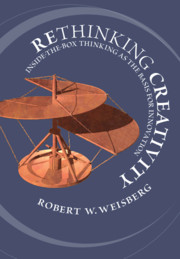Book contents
- Rethinking Creativity
- Rethinking Creativity
- Copyright page
- Dedication
- Contents
- Figures
- Tables
- Part I Introduction
- Part II Analytic Thinking in Creativity
- Part III The Question of Extraordinary Thought Processes in Creativity
- Part IV The Psychometrics of Creativity
- Part V The Neuroscience of Creativity
- 13 The Neuroscience of Creativity
- References
- Index
13 - The Neuroscience of Creativity
from Part V - The Neuroscience of Creativity
Published online by Cambridge University Press: 01 October 2020
- Rethinking Creativity
- Rethinking Creativity
- Copyright page
- Dedication
- Contents
- Figures
- Tables
- Part I Introduction
- Part II Analytic Thinking in Creativity
- Part III The Question of Extraordinary Thought Processes in Creativity
- Part IV The Psychometrics of Creativity
- Part V The Neuroscience of Creativity
- 13 The Neuroscience of Creativity
- References
- Index
Summary
Creativity has become a focal point in discussions of brain structures and processes in psychological functioning. The first part of Chapter 13 examines studies that have tried to isolate brain areas involved in creative thinking. The second section reviews research examining the link between brain structures involved in memory and those underlying imagination and other creative activities. This research provides a link between creative thinking and one component of analytic thinking, recalling information from memory. The third section examines changes in brain structure as the result of the acquisition of expertise, which links cognitive research on expertise and creativity, discussed in Chapter 6, with findings from neuroscience. The fourth section reviews research demonstrating that creative performance can be affected by brain stimulation. Theof the chapter reviews research that focuses on brain networks in creative thinking, specifically the default-mode network and the executive control network. The chapter ends by bringing the discussion full circle, examining the influence of the genius view on the neuroscience of creativity.
Keywords
- Type
- Chapter
- Information
- Rethinking CreativityInside-the-Box Thinking as the Basis for Innovation, pp. 423 - 457Publisher: Cambridge University PressPrint publication year: 2020

